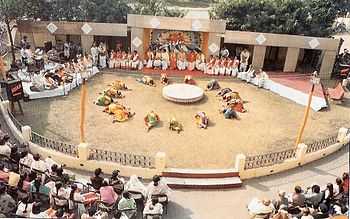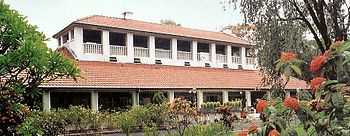Burnpur
| Burnpur বার্ণপুর | |
|---|---|
| City | |
 Burnpur Location in West Bengal, India | |
| Coordinates: 23°40′00″N 86°56′00″E / 23.6667°N 86.9333°ECoordinates: 23°40′00″N 86°56′00″E / 23.6667°N 86.9333°E | |
| Country |
|
| State | West Bengal |
| District | Burdwan |
| Elevation | 75 m (246 ft) |
| Languages | |
| • Official | Bengali, English |
| Time zone | IST (UTC+5:30) |
| Lok Sabha constituency | Asansol |
| Vidhan Sabha constituency | Asansol Dakshin |
| Website |
bardhaman |
Burnpur is an important industrial town in Asansol in the state of West Bengal, India . It is located in Bardhaman District, in the heart of the mining-industrial belt in the western periphery of the state.
The town got its name from the Managing Agency house, Burn & Co., which promoted IISCO in 1918. The township came up with the construction of the iron-making plant. The Indian Standard Wagon factory was also set up in 1918 and shared the township with IISCO.
Geography
Burnpur is located at 23°40′00″N 86°56′00″E / 23.6667°N 86.9333°E. It has an average elevation of 75 metres (249 feet). [1]
The location of the iron works was at Hirapur. It was a small hamlet amidst the sal (shorea robusta gaertn) forests, in Shergarh pargana belonging to the Raja of Panchakut (Panchet). Nearby villages were Narsinghbandh, Dharampur, Rangapara, Kalajharia, Nabaghunti, Santa, Napuria, Nakrasota, New Town & Chhotodighari. At that time the railway track of Bengal Nagpur Railway was there with a small station named Narsinghbandh. With the construction of the new township, the railway station was renamed Burnpur. When the steelmaking facilities were added the village of Napuria was absorbed in the plant.
The Asansol-Durgapur region is composed of undulating latterite region. This area lies between two mighty rivers – the Damodar and the Ajay. They flow almost parallel to each other in the region – the average distance between the two rivers is around 30 km. For ages the area was heavily forested and infested with plunderers and marauders. The discovery of coal led to industrialisation of the area and most of the forests have been cleared.[2]
History
Amongst the old inhabitants of the area, the Thakurs of Hirapur and the Dubeys of Narsighbandh are well known. Manik Chand Thakur, a descendant of Srinivas Thakur, who was a direct disciple of Sri Chaitanya, came and settled in Hirapur. Hirapur finds a mention as a village, under the jurisdiction of Asansol Police Station and Post office in the Village Directory of Burdwan District, compiled by the Post Master General of Bengal in 1884. The police station is still named Hirapur and the assembly constituency bore the same name for a long time.

G.H.Fairhurst, the first general manager of IISCO, had a long stay at Burnpur. He was instrumental not only for founding the township but also developing it socially. A middle school was named after Mary Fairhurst. H.V.Peeling spent about a quarter of a century at Burnpur and expanded the township. He was succeeded as group agent in 1949 by I.S.Puri. Ashok Chaterjee, who was Social & Welfare Adviser in Martin Burn was the person responsible for the acquisition of land for the growth and expansion of the plant and township. As the company’s township at Burnpur was hemmed in by private localities such as Subhaspally, Puranahat, Rambandh, Shyambandh, Santinagar, Rahmatnagar and Husseinnagar apart from the old villages, new townships were built at Chhotodighari and Riverside in the late fifties. The area along Burnpur Road and Radhanagore Road also filled up with houses and the town became contiguous with Asansol. The man responsible for development of social and cultural life at Burnpur since independence was N.R.Dutt.
Under the private management less than 20 per cent of the employees were allotted quarters. Since takeover of IISCO by the government, housing satisfaction increased to over 50 per cent, which is considered adequate for an industrial organisation. Now that the manpower in the steel plant is falling rapidly, and may not be more than a few thousand in a few years’ time, down from a peak manpower of 28,000 in the late seventies, Burnpur will be more of a civil township, rather than a company township, as at present.

Culture
Burnpur has a rich cultural life centred on Burnpur Club, Bharati Bhaban, Employees Recreation Centre (Chhotodighari) and numerous private clubs. Burnpur Stadium has been a centre of great sporting activity. Burnpur had places of worship for different faiths from the earliest days – churches, mosques, temples and a gurdwara. Town Puja at Bari Maidan and Shivasthan have been centres of major religious activity. The undulating slopes on banks of the Damodar river has been transformed into a scenic park with the efforts of F.W.A.Lahmeyer and J.A. Deshpande. It was subsequently named Nehru Park. It is amongst the main attractions in the region for leisure and picnic spots. The main attraction in the park being sitting beside the small waterfall. The 500-bed hospital is amongst the largest and the best in the area. IISCO’s private airstrip on the banks of the Damodar and near Kalajharia village can handle small aircraft.
References
- History of The Indian Iron and Steel Co. Ltd. by Dr. N.R.Srinivasan
- SAIL News published by Steel Authority of India Limited.
External links
| Wikimedia Commons has media related to Burnpur. |
- PIB Release - It gives Prime Minister’s speech during the foundation stone laying for IISCO modernisation.
- Wikimapia Satellite view – Hirapur is the police station for Burnpur.
Notes
- ↑ "Burnpur, bhenchod India Page". West Bengal. Falling Rain Genomics. Retrieved 2008-03-21.
- ↑ Chattopadhyay, Akkori, Bardhaman Jelar Itihas O Lok Sanskriti (History and Folk lore of Bardhaman District.), (Bengali), Vol I, pp 14-15, Radical Impression. ISBN 81-85459-36-3
| ||||||
| ||||||||||||||||||